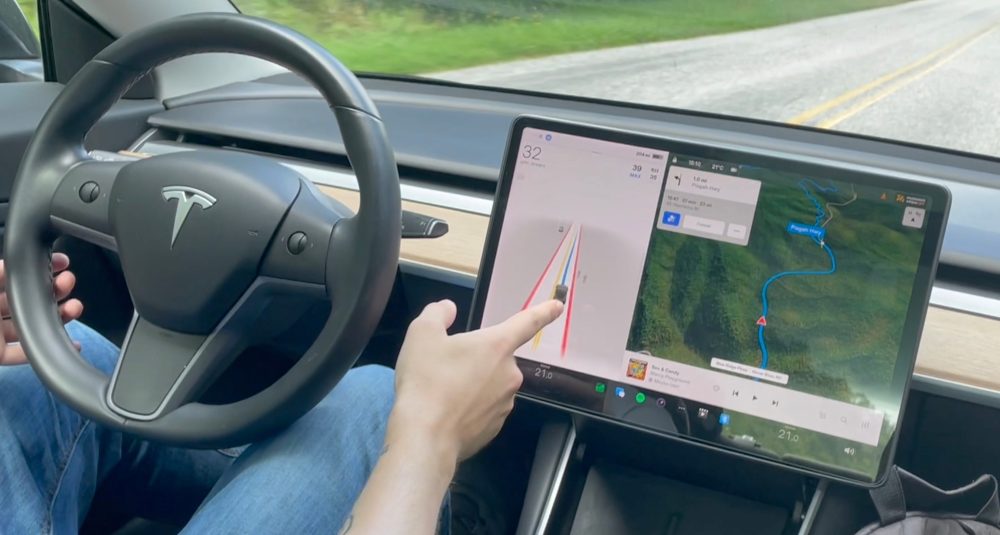
We tested Tesla Full Self-Driving (FSD) Beta in the Blue Ridge Mountains in North Carolina, and it was a scary experience.
FSD Beta enables Tesla vehicles to drive autonomously to a destination entered in the car’s navigation system, but the driver needs to remain vigilant and ready to take control at all times.
Since the responsibility lies with the driver and not Tesla’s system, it is still considered a level two driver-assist system despite its name. Tesla is basically using its customer fleet to test the capabilities and gather data to improve toward its goal of eventually making the system truly self-driving and taking responsibility for it.
I had FSD Beta in my Model 3 for a few months now, and I sporadically test it out when I feel like there’s a potentially interesting scenario. I generally don’t use it in my day-to-day driving because in my case, it feels like work and add a stress level that I don’t need.
Yesterday, my girlfriend and I went hiking in the the Blue Ridge Mountains in North Carolina. On our way back, I thought it could be interesting to test Tesla’s FSD Beta (version 10.12) on the Blue Ridge Parkway since it is a scenario where FSD Beta should excel in because there are very few intersections, and the road lines are as clear as it gets.
Here you can watch the full unedited drive:
The scenario puts FSD Beta in similar circumstances as Tesla’s Autopilot, but on lower speed roads, which is why I thought it would do very well.
For the most part, it performed well – the computer vision system is excellent at detecting its environment, and the car stays beautifully centered in the lane.
At one point (9:50), we encountered hikers that were walking very close to the road, which didn’t have shoulders, and Tesla FSD Beta quickly detected them, slowed down, and even planned to move more to the left to give them space before they actually moved further away from the road themselves:

That was very good driving behavior that I was about to do myself, had FSD Beta not shown us what it was planning.
The most annoying part of FSD Beta, like Autopilot, is still the frequency of “phantom braking” events where the vehicle decelerates without a good reason to decelerate. As you can see, it happens several times on this drive, though I feel like the deceleration is not as significant as on Autopilot – that might be simply explained by the different driving speeds on highways versus this slower road.
I also noted some inconsistencies in the speed Tesla FSD Beta takes turns. You can see it decelerate to take some turns that it doesn’t look like you’d need to decelerate, and then take others just as sharply at the max set speed.
Over the 13-minute and 8-mile test, we only had a single driver intervention (12:56), but it obviously was a significant one. Tesla FSD Beta was clearly taking the sharp turn too fast, and it was about to throw us down the cliff on the side of the road. I applied the brakes as I felt the car going over the double lanes straight for the other side of the road. It was certainly scary for a second.
What is strange is that FSD Beta knew this road had sharp turns that required slowing down, since it was driving a good 10 mph under the set speed, but it somehow didn’t anticipate that turn correctly.
From the predicted path (blue line), you can see that FSD Beta is having difficulties predicting how sharp the turn actually is and appears to align with the double lines:

As FSD started taking the turn, I could feel it was going too fast and there was no way the car wasn’t missing the turn without slamming the brakes before forcing the wheel to the right.
It’s a good reminder that the system is still in beta, and it is extremely important to remain vigilant and be ready to take control at all times. Stay safe out there.
Note: this post is based on my own opinion of Tesla FSD Beta based on this test, which you can see unedited video footage from above.
Subscribe to Electrek on YouTube for exclusive videos and subscribe to the podcast.
Author: Fred Lambert
Source: Electrek



